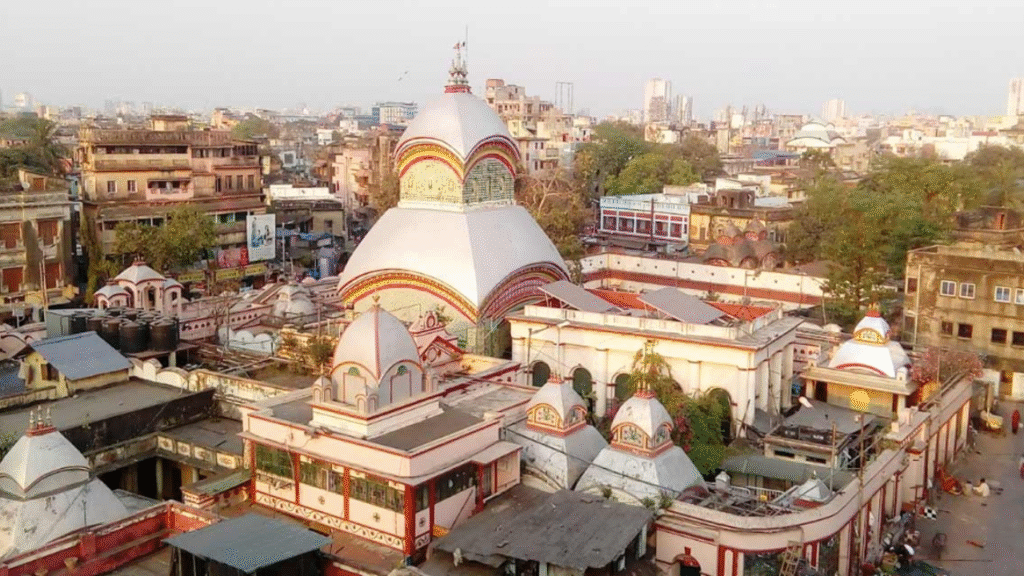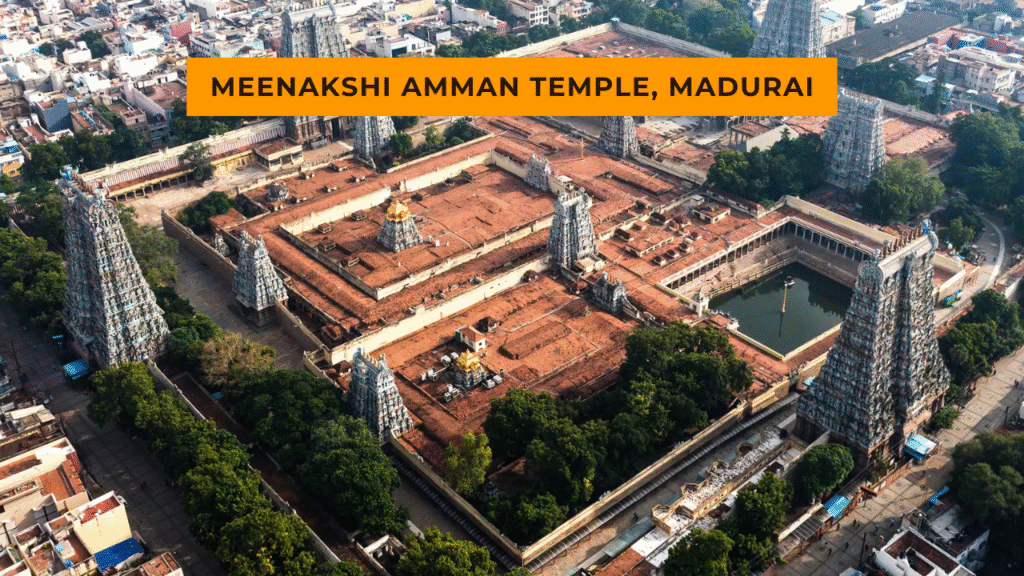The Kalighat Kali Temple in Kolkata, West Bengal is one of the most sacred and revered shrines dedicated to Goddess Kali in India. It is considered one of the 51 Shakti Peethas, where the divine energy of the Goddess is worshipped with deep devotion. The temple not only holds immense spiritual significance but also represents the rich cultural and historical heritage of Kolkata. Thousands of devotees and tourists visit this temple daily, seeking blessings, peace, and liberation.
| Temple Name | Kalighat Kali Temple |
| Location | Kalighat, Kolkata, West Bengal |
| Deity | Goddess Kali (Dakshina Kali form) |
| Mythological Significance | One of the 51 Shakti Peethas – believed to be the site where the right toe of Goddess Sati fell |
| Built By | Current structure built in the 19th century by the Sabarna Roy Chowdhury family |
| Architecture | Traditional Bengali temple style with Natmandir (hall) and Garbhagriha (sanctum) |
| Main Idol Features | Three eyes, long golden tongue, silver garland of human heads |
| Important Festivals | Kali Puja (Diwali), Durga Puja, Poila Boishakh, Snan Yatra, Rath Yatra |
| Daily Rituals | Mangala Aarti (morning), Bhog Aarti (midday), Sandhya Aarti (evening) |
| Offerings | Red hibiscus flowers, sweets, coconuts, sarees |
| Sacred Spot | Kundupukur – holy tank for purification and rituals |
| Cultural Significance | Influenced Bengali art, literature, and origin of famous Kalighat paintings |
| Best Time to Visit | During Kali Puja/Diwali for grandeur; weekdays for peaceful darshan |
| Accessibility | Well-connected by road, metro (nearest: Kalighat Metro Station) |
| Special Belief | Devotees believe Goddess Kali here removes suffering, grants protection, prosperity, and spiritual awakening |
Historical Significance of Kalighat Temple
The origins of Kalighat Kali Temple are traced back to ancient times. According to Hindu mythology, when Lord Shiva wandered across the universe carrying the body of Goddess Sati, her body parts fell on different parts of the earth. These sites came to be known as Shakti Peethas. It is believed that the right toe of Goddess Sati fell at Kalighat, making it a sacred site for worshippers of Shakti.
The present temple structure was built in the early 19th century by the Sabarna Roy Chowdhury family, one of the prominent zamindars of Bengal. Over the years, the temple has become a major spiritual landmark and an integral part of Kolkata’s religious identity.
Architectural Beauty of Kalighat Kali Temple
The architecture of Kalighat Temple is a blend of traditional Bengali style with elements of modern renovations. The temple has a three-storied structure with a distinctive natmandir (prayer hall) and garbhagriha (sanctum sanctorum).
The main idol of Goddess Kali, worshipped as Dakshina Kali, is unique and striking. Unlike conventional depictions of Kali, the idol here has three huge eyes, a long protruding tongue made of gold, and is adorned with a garland of human heads carved in silver. The deity is decorated daily with fresh flowers, ornaments, and red hibiscus garlands, which are considered very dear to Goddess Kali.
Spiritual Importance and Beliefs
Devotees believe that offering prayers at Kalighat Kali Temple brings relief from suffering, removes obstacles, and grants protection and prosperity. The Goddess is worshipped as the Mother of the Universe, fierce yet compassionate.
Kalighat is also associated with Tantric practices, and many sadhus and devotees come here to perform spiritual rituals. It is believed that Goddess Kali fulfills the wishes of her true devotees and blesses them with spiritual awakening.
Timing Table
| Ritual / Darshan | Timings |
|---|---|
| Temple Opening Time | 5:00 AM |
| Mangala Aarti | 4:00 AM – 6:00 AM |
| General Darshan (Morning) | 5:00 AM – 2:00 PM |
| Bhog Offering & Afternoon Break | 2:00 PM – 5:00 PM (temple closed for darshan) |
| General Darshan (Evening) | 5:00 PM – 10:30 PM |
| Sandhya Aarti | Around 7:00 PM – 8:00 PM |
| Temple Closing Time | 10:30 PM |
Daily Rituals and Worship
The temple follows a series of daily rituals that attract large crowds. The day begins with Mangala Aarti early in the morning, followed by Bhog Aarti and Sandhya Aarti in the evening. The temple priests perform rituals with lamps, conch shells, bells, and devotional songs, creating a highly spiritual atmosphere.
The offerings made to the Goddess generally include red hibiscus flowers, sweets, coconuts, and sarees. The temple also has facilities for devotees to perform special pujas and homas.
Festivals Celebrated at Kalighat
Festivals at Kalighat Kali Temple are celebrated with great enthusiasm and devotion. The most significant celebrations include:
- Kali Puja – The grandest festival of the temple, held during Diwali, when thousands of devotees throng to the temple. The Goddess is adorned with rich ornaments, and special rituals continue throughout the night.
- Durga Puja – Though the temple is dedicated to Kali, the nine-day Durga Puja celebrations are also significant here.
- Poila Boishakh (Bengali New Year) – Devotees visit the temple to seek blessings for prosperity and happiness.
- Snan Yatra and Rath Yatra – Special rituals and processions are organized during these occasions.
During these festivals, the temple becomes a hub of devotion, music, lights, and rituals, attracting visitors from across India and abroad.
The Sacred Tank – Kundupukur
The Kundupukur, or the sacred tank near the temple, is another important spot within the temple premises. Devotees believe that taking a dip in this holy water purifies the soul and fulfills wishes. Traditionally, this tank is also used for performing rituals for departed ancestors.
Kalighat Temple in Kolkata’s Culture
The Kalighat Temple is not just a place of worship but also an integral part of Kolkata’s cultural and social fabric. The locality around the temple, also called Kalighat, is bustling with shops selling religious items, sweets, and souvenirs. The temple has also influenced Bengali art and literature, especially through the famous Kalighat paintings, which originated in this area in the 19th century.
Kalighat remains a symbol of Kolkata’s spiritual identity, connecting the past with the present.
Visiting Information
The temple is located in the heart of Kolkata and is easily accessible by road, metro, and other means of transport. The nearest metro station is Kalighat Metro Station, just a short walk from the temple.
The temple is usually crowded, especially on Tuesdays and Saturdays, which are considered auspicious days for worshipping Goddess Kali. Devotees are advised to visit early in the morning to avoid long queues.
Best Time to Visit
The best time to visit Kalighat Temple is during Kali Puja and Diwali, when the temple is beautifully decorated with lights and flowers. However, for those who wish to avoid heavy crowds, weekdays and non-festival days are more peaceful for darshan.



